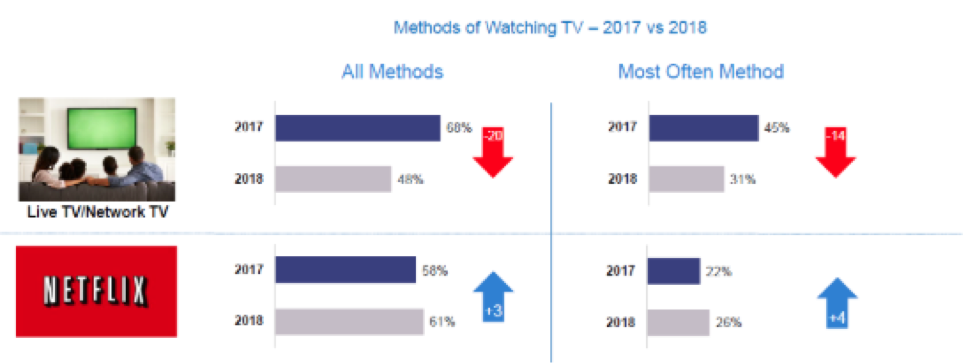Editor’s note: Mario X. Carrasco is co-founder and principal of ThinkNow Research, a market research agency based in Burbank, Calif. This is an edited version of a post that originally appeared under the title, “How Netflix cracked the cross-cultural code.”
With its ongoing investment in original content, Netflix continues its dominance over traditional broadcast and is slowly but steadily disrupting the reign of large movie studios. Expected to spend $13 billion on original programming this year, Netflix clearly has no plans to slow down. In fact, our most recent study highlights its meteoric rise across the total market, noting the viewership gap narrowing between live TV and Netflix (six points in 2018 vs. 23 points in 2017):

Because Netflix has successfully disrupted the linear programming model and is now revered for the quality of its original content, which includes a wide variety of programming from original stand-up specials to blockbuster movies, it’s difficult to pinpoint just one reason for the company’s growth in popularity. One thing is certain from the insights gleaned from our most recent study, Netflix has cracked the cross-cultural code.
Multicultural consumers are the fastest-growing segment of the U.S. population. Already over 120 million strong, and increasing by 2.3 million per year, multicultural populations are the growth engine of the U.S. population. Groups such as U.S. Hispanics, African-Americans and Asian-Americans already make up 38 percent of the U.S. population and the Census projects that multicultural populations will become a numeric majority by 2044.
Netflix has come of age in this new demographic reality and has seized the moment. Their dedication to creating diverse content spans from casting to storytelling, production to direction, and they are being rewarded with loyalty. While live TV has dropped across all ethnicities from 2017 to 2018, the most significant drops were among cross-cultural audiences:

African-Americans drove the largest drop in live TV viewing with a 22-point decrease. Hispanics drove the second-largest point decrease in live TV viewing with a 17-point decrease. It is important to note that while live TV continues to top the list of how TV programming is watched most often, Hispanics are the only segment who reports favoring Netflix (35 percent) over live TV (27 percent). Asian-Americans experienced the smallest decline in live TV viewing preference with six points and the most modest increase in Netflix as the most often used for watching TV programming with a two-point lift.
How did Netflix crack the cross-cultural code?
While almost all companies and brands understand the importance of multicultural consumers, few have gained as much traction as Netflix has in recent years. Here are three key lessons we can learn from Netflix:
1. Make multicultural consumers a priority. Despite the growth predictions and purchase power of multicultural consumers, companies often relegate their multicultural efforts to small silos. Netflix has flipped that model on its head by leading with multicultural efforts as early as Narcos in 2015, a cross-cultural smash to their Strong Black Lead campaign that launched this year prompting Essence to ask, “Is Netflix the new Mecca for Black content?” Netflix is proving that leading with multicultural is a recipe not only for success among multicultural viewers but viewers at large in the U.S. and even globally.
2. Cultural competency is key. On the surface, it may seem as though Netflix’s strategy is simple: cast multicultural actors and produce multicultural stories. However, the formula is deeper than that. While it is true that Netflix has made significant efforts to cast multicultural actors and hire multicultural talent behind the camera, the real key to their cross-cultural success is cultural competency. Looking at Narcos, for example, the producer spent years researching the intricacies of the rise and fall of Pablo Escobar. While marketers don’t have years to get cultural nuances right, getting genuine insights through MR are key to successful multicultural marketing campaigns.
3. Diversity is a business imperative. The ethical implications of diversity in the workplace and media are clear. However, diversity is not just an ethical imperative, it is a business imperative. Studies have shown a direct link between diverse teams and increased productivity/output. Netflix has demonstrated how diversity in media both in front of and behind the camera can lead to increased revenues.
Identifying opportunities
Ultimately, the takeaway is this: Creating content that appeals to a multicultural audience is no longer a box you check and then move on. As Netflix has proven, looking at the total market to identify opportunities to tell untold stories that not only draw attention to underserved segments but also appeal to the greater cross-cultural community positions your firm to start taking mind share away from companies that haven’t figured it out yet. In a time when competitive advantage is waning across multiple brands, having a clear understanding of diversity and cultural competency puts you ahead.
